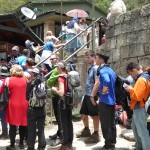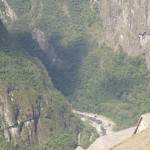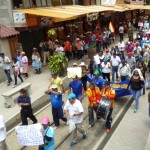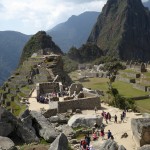 In a recent trip to South America, my wife and I traveled into Peru, up to Cusco, and finally to Machu Picchu. It’s a place I’ve dreamed about going for years—as about 4,000 people a day also dreamed about! (Luckily, we were off season and it wasn’t too crowded) But the crowds didn’t cause our problem. Here’s what it was like to be trapped at Machu Picchu.
In a recent trip to South America, my wife and I traveled into Peru, up to Cusco, and finally to Machu Picchu. It’s a place I’ve dreamed about going for years—as about 4,000 people a day also dreamed about! (Luckily, we were off season and it wasn’t too crowded) But the crowds didn’t cause our problem. Here’s what it was like to be trapped at Machu Picchu.
Everyone who wants to see the ruins must enter a “funnel” that gets narrower as you get closer to Machu Picchu. The “funnel” means you must go from Lima is through Cusco, with its small airport and one runway. From there, you get on a bus that travels into the Sacred Valley along only one, narrow road. You’re still not there. You must transfer to a small train—only one goes into Machu Picchu and only one comes out. Once in the tiny tourist town of Aguas Calientes, you still aren’t done You must stand in line for a bus that labors up the switch-backs on the mountain to reach Machu Picchu.
As they say: the view is stunning! It is larger than I thought and greener. Unlike the mountains in our Rockies which have long, sloping sides, the mountains here rise straight out of the river valley, thousands of feet below. That means when you walk to the edges of Machu Picchu, the drop goes straight down. And there are no guard rails! 
 Unfortunately, Peru doesn’t have any restrictions on the ruins which means people crawl all over everything and can take pieces of it away, hidden in their pockets.
Unfortunately, Peru doesn’t have any restrictions on the ruins which means people crawl all over everything and can take pieces of it away, hidden in their pockets.
We spent a long afternoon there, enjoying the unusually clear day, as it rains or mists most of the time. After waiting for an hour for the bus, we got back to Aguas Calientes and prepared to leave. Instead, the transportation workers went on strike and shut down the only train to get out of the valley. They marched in the streets in noisy protest, trapping many of us inside the hotel. The protesters were upset because: the Peruvian government has talked about privatizing not only the electric and water sources but also Machu Picchu. The workers were worried it would turn into “Disney Picchu.”
We also discovered that of the billions of dollars made off tourists at the ruins, most of it goes back to the bureaucrats in Lima with very little staying the in the local community, particularly the indigenous Indians who are descendants of the Incas who built Machu Picchu.
After a second day of trying to squeeze on the one train car that left, we managed to get on the last car leaving for the day. When we got back to Cusco, we all thought we’d escaped and could leave for Lima. Wrong. A plane had crashed in Cusco’s small airport which shut it down for days. The “funnel” was blocked again. Thousands of tourists clogged the city, all trying to get out at the same time.
Luckily, our tour company offered us an 11-hour bus ride to the coast where we could catch a plane back to Lima. (Luckily??) The bus traveled over one of the highest, barren plateaus in the country—which resembled Nevada: bleak, no trees, little water, and little life of any kind. When the driver offered to stop for lunch, we all screamed, “NO! Get us back to Lima!!”
Of course, we made it.
 And you should pursue your dreams of seeing Machu Picchu as we did. Just be prepared to be trapped in the “funnel” that leads to the sacred and mysterious ruins. Even in 2015, it’s still difficult to reach the splendor of the mountain-top spectacle.
And you should pursue your dreams of seeing Machu Picchu as we did. Just be prepared to be trapped in the “funnel” that leads to the sacred and mysterious ruins. Even in 2015, it’s still difficult to reach the splendor of the mountain-top spectacle.






